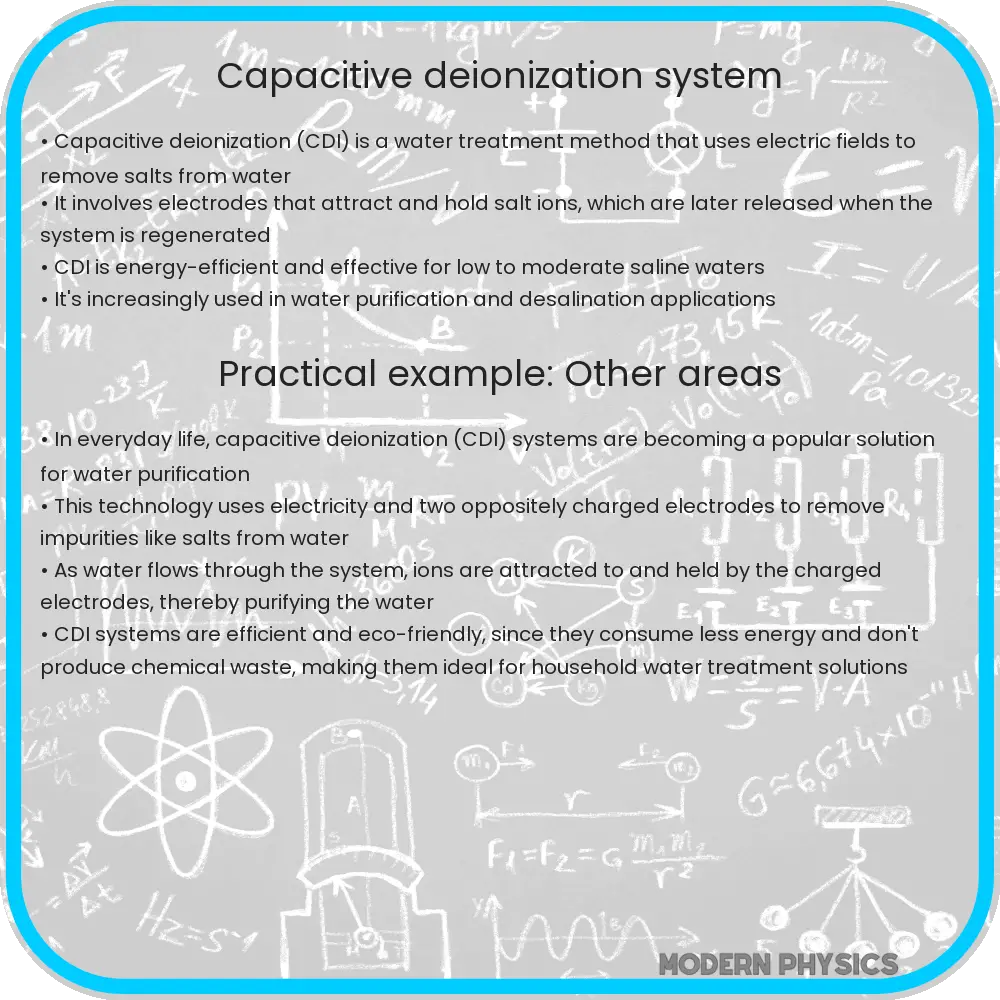Explore Capacitive Deionization: an eco-friendly, energy-efficient water treatment technology, revolutionizing desalination and purification.

Understanding Capacitive Deionization (CDI) Technology
Capacitive Deionization (CDI) is emerging as a groundbreaking solution in water treatment technology. Characterized by its efficiency, low-energy consumption, and eco-friendly nature, CDI represents a significant advancement in desalination and water purification processes. This article delves into the principles, benefits, and potential applications of CDI systems, offering an insightful perspective for environmental scientists, engineers, and anyone interested in sustainable water treatment solutions.
Principles of Capacitive Deionization
At its core, CDI operates on the principles of electrochemistry. The system utilizes two oppositely charged electrodes, usually made of carbon materials, to remove dissolved salts and impurities from water. When a voltage is applied, ions in the water are attracted to and held by the electrodes, a process known as electrosorption. Notably, positive ions move towards the cathode and are captured by negatively charged electrodes, while negative ions are drawn to and absorbed by the anode.
Advantages Over Conventional Desalination Methods
CDI holds several advantages over traditional desalination methods like Reverse Osmosis (RO) and Distillation. Firstly, it consumes significantly less energy, primarily because it operates at lower pressures and does not require phase change of the water. Secondly, CDI systems have a smaller environmental footprint. They do not generate the same level of brine waste as RO, making them a more eco-friendly option. Moreover, the use of chemical-free processes in CDI further underscores its environmental benefits.
Applications and Potential Impact
CDI technology finds applications in various sectors including municipal water treatment, industrial water processing, and even in remote or off-grid locations where traditional energy-intensive desalination methods are impractical. Its adaptability to varying scales, from small, portable units to large-scale installations, makes it a versatile tool in addressing global water scarcity issues. Additionally, ongoing research and development in CDI technology aim to enhance its efficiency and expand its capabilities, potentially making it a cornerstone technology in sustainable water management.
Key Challenges and Future Outlook
Despite its advantages, CDI faces certain challenges. Scalability and cost-effectiveness are areas needing improvement for broader adoption. Research is also focused on enhancing electrode materials for higher ion removal efficiency and longer life cycles. As these challenges are addressed, CDi’s future looks promising, especially in a world increasingly focused on sustainable and energy-efficient technologies.
Enhancing Efficiency and Sustainability with Advanced Materials
One of the most dynamic areas of CDI research lies in the development of advanced materials for electrodes. Innovations in nanoporous carbon materials, carbon aerogels, and graphene-based composites have shown potential to significantly increase the ion adsorption capacity and energy efficiency of CDI systems. These materials offer higher surface areas and electrical conductivity, leading to faster ion transport and better desalination performance. Moreover, the durability and regeneration capabilities of these advanced materials can greatly extend the lifespan of CDI systems, making them more cost-effective in the long run.
Integrating CDI with Renewable Energy Sources
Integrating CDI systems with renewable energy sources such as solar or wind power further enhances their eco-friendly profile. This integration not only reduces the operational carbon footprint but also enables the deployment of CDI systems in remote areas without reliable access to the electrical grid. The synergy between renewable energy and CDI technology could be a game-changer in providing clean water in underdeveloped or disaster-stricken regions.
Regulatory and Market Trends
The rising focus on sustainable water management practices has led to supportive regulatory frameworks and incentives for technologies like CDI. Governments and international organizations are increasingly recognizing the potential of low-energy, eco-friendly water treatment solutions. This trend, coupled with growing market demand for efficient water purification systems, is likely to drive significant investments and innovations in the CDI sector.
Conclusion
In summary, Capacitive Deionization emerges not just as an innovative technology but as a beacon of hope in the quest for sustainable water treatment. Its low-energy profile, minimal environmental impact, and potential integration with renewable energy sources position CDI as a key player in the future of desalination and water purification. As research continues to overcome its current limitations and as market and regulatory environments evolve, CDI stands poised to make a substantial contribution to global water security. Embracing this technology could lead us to a future where access to clean, safe water is a reality for all.
